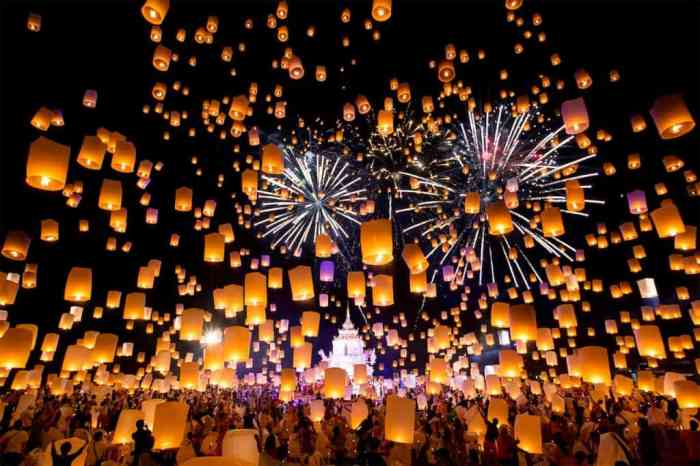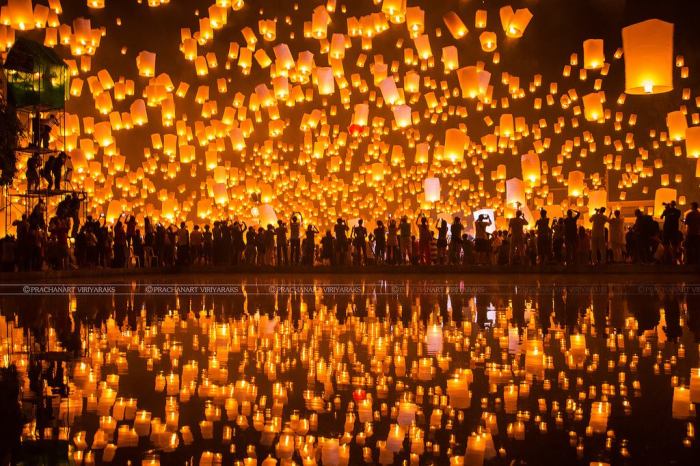Chiang Mai Lantern Festival, also known as Yi Peng, is a breathtaking spectacle of light and color, a mesmerizing blend of ancient tradition and modern celebration. Thousands of sky lanterns illuminate the night sky, transforming Chiang Mai into a celestial wonderland. This festival, steeped in rich history and spiritual significance, draws visitors from around the globe, eager to witness this unique cultural event.
Beyond the stunning visuals, the festival offers a deeper dive into Thai culture, beliefs, and artistry, creating an unforgettable experience.
The release of these lanterns isn’t merely a visual display; it’s a symbolic act, representing wishes sent to the heavens and a connection to the spiritual realm. The festival’s vibrant atmosphere, filled with the aroma of delicious street food and the sounds of traditional music, further enhances its allure. Understanding the history, significance, and impact of this event paints a complete picture of its profound cultural importance.
History of the Chiang Mai Lantern Festival

The Chiang Mai Lantern Festival, also known as Yi Peng, is a breathtaking spectacle of thousands of illuminated sky lanterns gracefully ascending into the night sky. But beyond the stunning visuals lies a rich history steeped in tradition and belief, a story that unfolds over centuries. Understanding this history enhances the experience of witnessing this magical event.Yi Peng’s origins are deeply rooted in the Lanna Kingdom, a historical Tai kingdom that once flourished in northern Thailand.
While the precise origins are debated, the festival’s association with the Loy Krathong festival, celebrated throughout Thailand, is undeniable. Loy Krathong, meaning “to float a basket,” involves releasing small, decorated rafts onto waterways, symbolizing the letting go of negativity and bad luck. Yi Peng, however, distinguishes itself through the majestic release of khom loy, or sky lanterns.
The Historical Significance of Releasing Sky Lanterns, Chiang Mai Lantern Festival
The release of sky lanterns holds profound symbolic meaning within the context of Yi Peng. These aren’t simply decorative items; they represent offerings to the gods, a gesture of respect and gratitude. Historically, the lanterns were believed to carry prayers and wishes heavenward, acting as a conduit between the earthly realm and the spiritual. The act of releasing a lantern into the night sky is seen as a symbolic release of one’s burdens and anxieties, a cleansing ritual to start anew.
The gentle ascent of the lantern, a small light against the vast darkness, mirrors the hope for a brighter future.
Traditional Beliefs and Practices Associated with the Festival
Yi Peng is more than just a visual spectacle; it’s a deeply spiritual event. Traditional practices often involve making merit at temples, participating in religious ceremonies, and offering prayers for good fortune and prosperity. Families gather, sharing meals and engaging in communal activities, strengthening familial bonds. The vibrant colors and intricate designs of the lanterns themselves reflect the artistry and cultural heritage of the Lanna people.
The preparation of the lanterns is often a family affair, passed down through generations, preserving the traditions and skills associated with the festival. The release of the lanterns is a carefully orchestrated event, often synchronized to create a truly awe-inspiring display.
Comparison with Similar Festivals
While Yi Peng is unique to northern Thailand, it shares similarities with other lantern festivals around the world. The release of lanterns as a form of celebration and wish-making is echoed in various cultures. However, Yi Peng distinguishes itself through its scale and the profound spiritual significance attached to the release of the khom loy. The integration of the festival with Loy Krathong, creating a unique blend of water-based and sky-based rituals, further sets it apart.
Festivals in other parts of Thailand, while incorporating elements of Loy Krathong, lack the widespread and spectacular release of sky lanterns that characterizes Yi Peng in Chiang Mai. Similarly, while other cultures have lantern festivals, few match the spiritual depth and cultural significance embedded in the Yi Peng tradition.
The Significance of Sky Lanterns: Chiang Mai Lantern Festival

The sky lanterns, orkhom loy*, are the undeniable heart of the Chiang Mai Lantern Festival, transforming the night sky into a breathtaking spectacle of light and color. Their significance extends far beyond mere aesthetics; they represent a profound connection between the earthly and spiritual realms, carrying hopes, dreams, and prayers aloft on the gentle night breeze. Understanding the symbolism woven into these delicate creations is key to grasping the festival’s true essence.The symbolism of the sky lanterns is rich and multifaceted.
The act of releasing a lantern itself symbolizes letting go of the past, releasing worries and anxieties, and making space for new beginnings. The rising light represents hope and aspirations ascending towards the heavens, a tangible manifestation of one’s wishes taking flight. The colors of the lanterns further enhance this symbolism. Warm colors like red and orange often represent good fortune and prosperity, while cooler hues like blue and purple might signify peace and tranquility.
Each individual lantern, therefore, becomes a personalized message sent to the universe.
Sky Lantern Symbolism and Colors
The color choices in sky lantern design are not arbitrary. Red, a vibrant and auspicious color in many Asian cultures, is often chosen to symbolize good luck and prosperity. Yellow, associated with the sun and royalty, signifies honor and respect. White, representing purity and peace, is often used to honor ancestors or to convey a sense of serenity.
The choice of color, therefore, reflects the individual’s intentions and the specific message they wish to convey through their lantern. A combination of colors can create even more nuanced meanings, layering hopes and wishes into a single, radiant display.
Cultural and Spiritual Meanings
Releasing sky lanterns is deeply ingrained in the cultural and spiritual fabric of northern Thailand. The act is often viewed as a way to connect with loved ones who have passed away, sending messages of remembrance and love into the heavens. It’s also a time for expressing gratitude for blessings received and making offerings to the spirits. The gentle ascent of the lanterns into the darkness represents the release of burdens and the pursuit of enlightenment, echoing the Buddhist principles of letting go of attachment and striving for inner peace.
The collective release of thousands of lanterns creates a powerful and moving spectacle, uniting the community in a shared experience of hope and aspiration.
Sky Lantern Craftsmanship and Materials
The creation of a sky lantern is a delicate and skilled process. Traditionally, the frame is constructed from thin bamboo strips, meticulously woven into a lightweight yet sturdy structure. This frame is then covered with a thin, translucent paper, often rice paper, allowing the light from the small candle or LED light source within to shine through. The paper is carefully glued or pasted onto the bamboo frame, requiring patience and precision to avoid tears or wrinkles.
The final step involves attaching the small candle or LED light source securely inside the lantern. Modern lanterns often incorporate more durable materials and safer light sources, but the traditional methods remain highly valued for their artistry and connection to the festival’s heritage.
Types of Sky Lanterns
The following table illustrates the variety of sky lanterns used during the festival, showcasing the diversity in size, shape, and design. While variations exist, these examples represent the common types encountered.
| Lantern Type | Description | Size (Approximate) | Distinguishing Features |
|---|---|---|---|
| Traditional Khom Loy | Round, typically made from rice paper and bamboo. | 1-2 feet in diameter | Simple design, often featuring a single color or a simple pattern. |
| Elaborate Khom Loy | Larger and more ornate, with intricate designs and multiple colors. | 2-3 feet in diameter | May incorporate additional decorations, such as tassels or ribbons. |
| Shaped Khom Loy | Designed in various shapes, such as animals or stars. | Variable, depending on the shape. | More complex construction, requiring advanced craftsmanship. |
| Modern LED Lanterns | Utilize LED lights instead of candles for increased safety. | Variable size and shapes. | Often feature more vibrant and varied colors. |
The Chiang Mai Lantern Festival transcends a mere celebration; it’s a captivating journey through time, culture, and spirituality. From the intricate craftsmanship of the sky lanterns to the profound symbolism of their release, every aspect contributes to the festival’s enchanting aura. While concerns about environmental impact exist, the ongoing efforts towards sustainable practices ensure the festival’s longevity and continued ability to captivate audiences worldwide.
Experiencing this event is to witness a powerful testament to the enduring spirit of Thai tradition and its ability to connect with the hearts and minds of people across the globe.